How To Discern Between Cat Ear Mites Vs Wax (Best Answer)
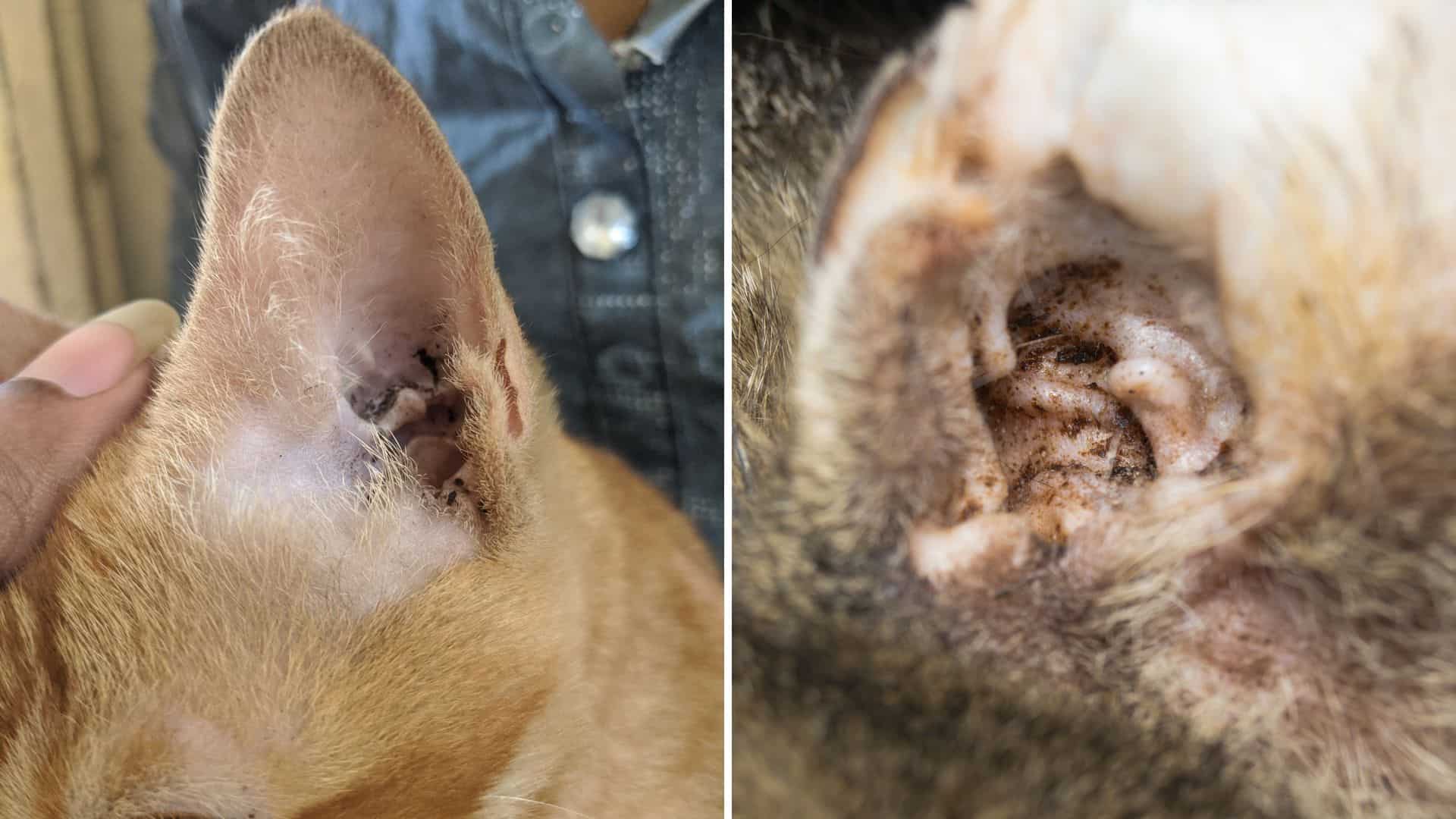
If your cat has ear wax, the ear wax will be light-brown, and there will be no smell. However, if ear mites are present, while you won’t be able to see them with your naked eye, the change in ear wax will be noticeable.
Cat ear mites vs wax can be hard to discern as they most usually come together, so if you notice too much earwax, expect ear mites as well. Ear wax is almost always present, and a little bit of ear wax is actually good for your cat’s health.
Ear wax protects your cat’s ears from infections, however, when it’s accompanied by ear mites, that is not good. Your vet will make a final diagnosis, but you can probably guess if you notice that the ear wax is darker in color and that it smells.
Read on for more helpful information to learn the best way of distinguishing between cat ear mites vs wax.
What’s The Difference Between Cat Ear Mites Vs Wax
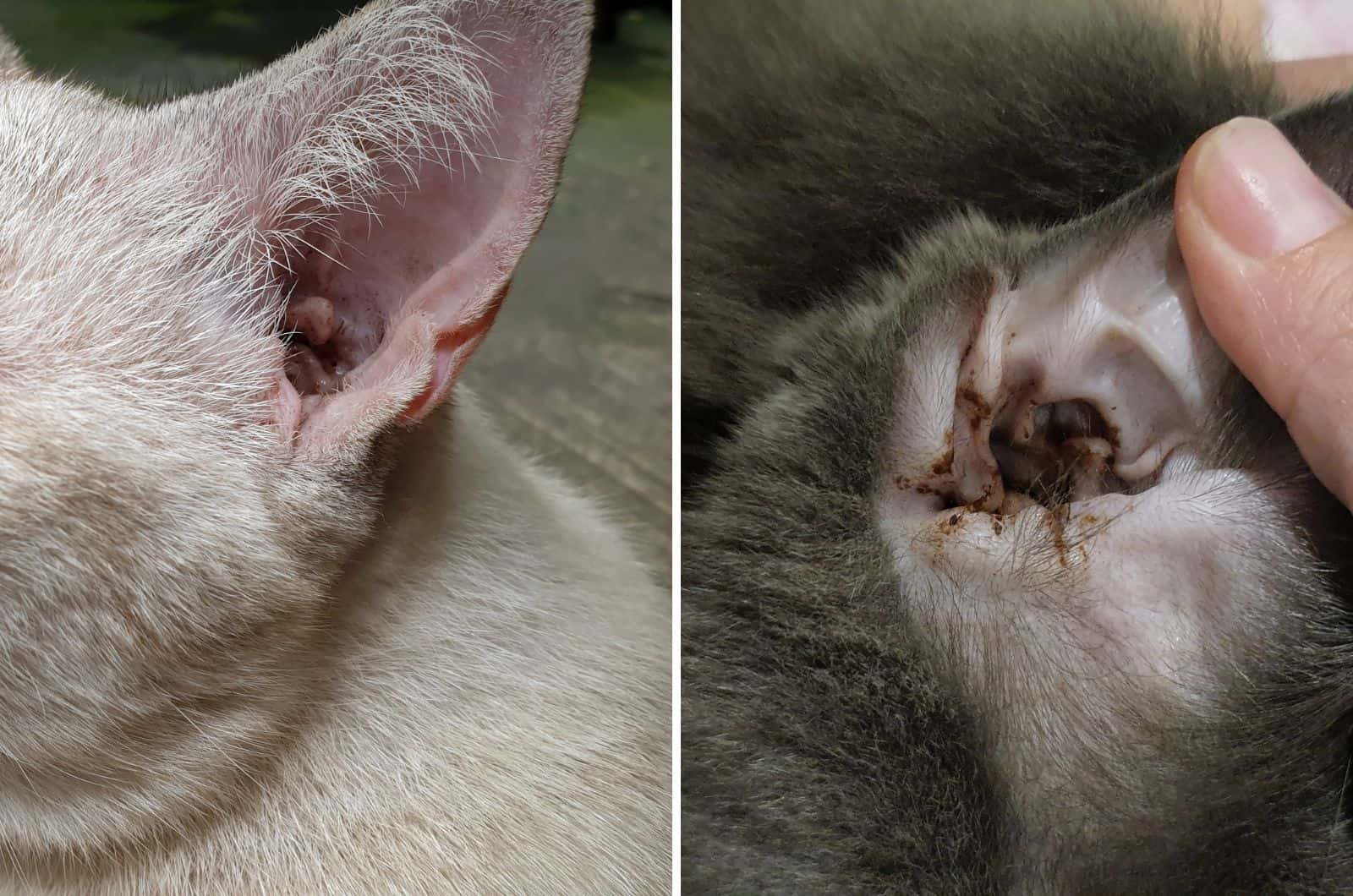
Earwax is a perfectly normal occurrence. Ear mites, on the other hand, are not and the cat should be examined and treated by a vet. While ear mites are rarely dangerous, they can have long-term consequences if not diagnosed early.
When it comes to your cat, it can be difficult to distinguish between earwax and ear mites. Fortunately, there are some distinctions that can help.
Cat Ear Wax
Earwax alone is not a reason to take your cat to the vet, but ear mites definitely are. Cats’ ears do not typically have a lot of earwax. If a cat happens to have a lot of earwax, it could be a sign of an underlying issue.
This is particularly true if the earwax is dark-colored or stinky. Earwax production will increase due to yeast and fungal infections, for example. Normal ear appearance in cats includes little earwax and pale pink skin.
If your cat’s earwax is thick, dark, and stinky, you may have an underlying problem. It is critical to understand that earwax and ear mites are not mutually exclusive. Ear mites can also be recognized by an increase in earwax.
As a result, if your cat has a lot of earwax, he or she may have ear mites as well.
Cat Ear Mites
Ear mites are micro bugs that usually live in the ear canals of animals such as cats. They are common in sick cats, kittens, and animals with weakened immune systems. Ear mites, on the other hand, do not always occur as a result of an underlying problem.
Ear mites are frequently the only problem. They are frequently found in dog ears, so beware of their ability to jump from dogs to cats. However, they are not common for humans.
They are so tiny that they can only be seen through a microscope. As a result, you won’t be able to see them simply by looking into your cat’s ear. However, you can check your cat for other symptoms too, to see if there is an ear mite infestation.
Common Symptoms
• inflamed skin around the ear
• excessive head shaking
• tilted head
• irritated ear canal
• dark ear discharge
• earwax buildup
• cat acting disoriented
• unpleasant odor from cat’s ear
Keep in mind that these signs are not always ‘ear mite symptoms’ as well. Many of the symptoms are similar to those seen in other cat ear conditions.
If a cat continues to shake its head but has no mites, it could be due to an ear infection, polyps in the cat’s ear canal, or a foreign body lodged inside of the ear.
There is also the possibility that your cat is shaking its head for non-medical reasons; e.g. sometimes cats shake their heads if some food gets stuck in their teeth while eating.
This indicates that your cat is experiencing problems eating or is suffering from a dental disease rather than ear mites. As ear mites are tiny parasites that are difficult to see with the naked eye, you need to pay your vet a visit.
So What’s The Difference?
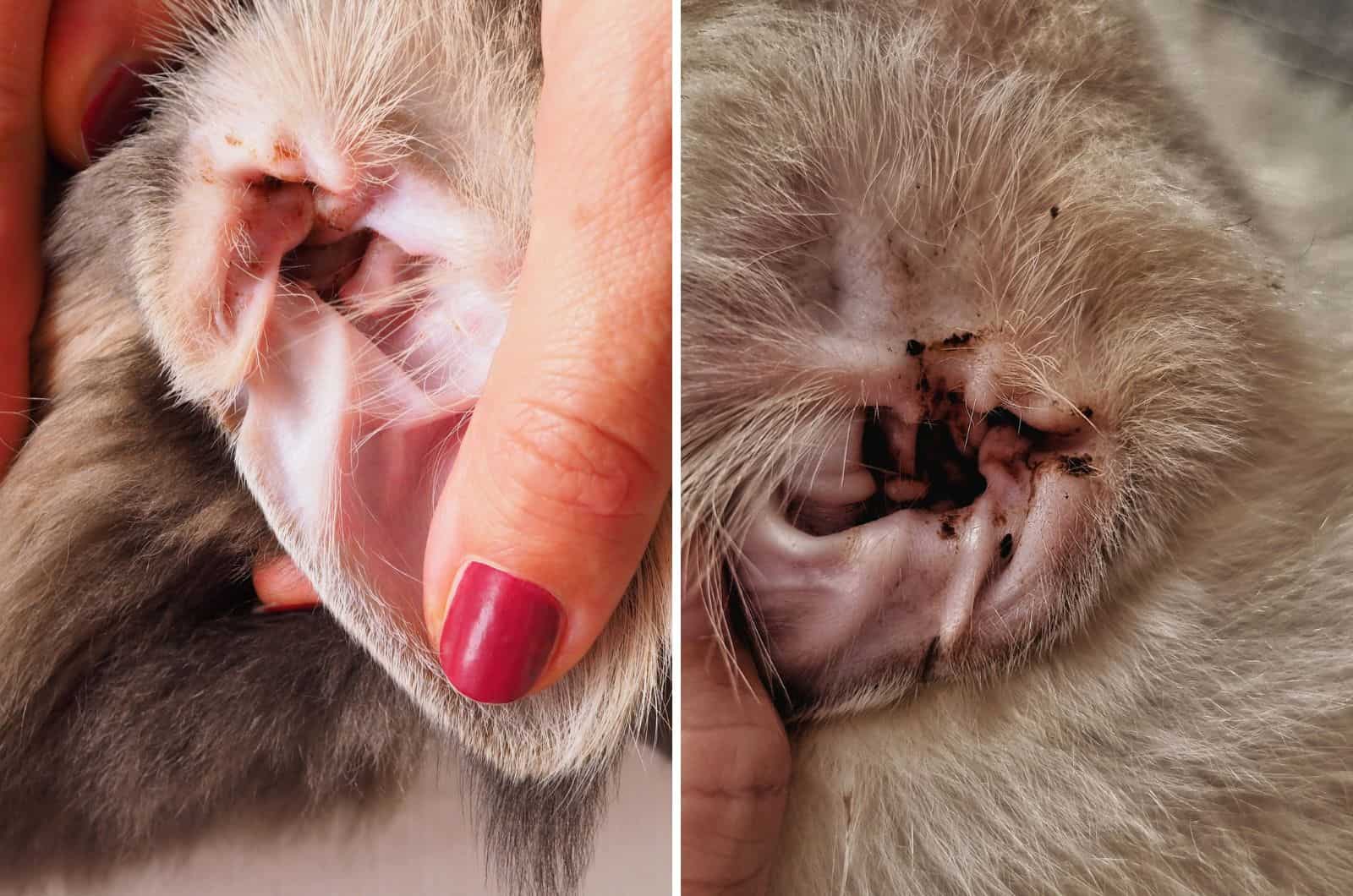
Earwax is actually quite common, but too much of it can be harmful to your cat. Earwax is usually the result of an underlying issue, such as ear mites. So, distinguishing between cat ear mites vs wax is often redundant.
Instead, you’re attempting to determine whether or not your cat’s earwax indicates the presence of an ear mite infestation. Ear mites usually cause cat earwax to be darker
It can be difficult to understand what color is considered normal and what is darker if you haven’t paid attention to it before. There’s another clear indication that might be helpful, and that’s the presence of a bad odor coming from the cat’s ear.
You’ll notice this when you clean your cat’s earwax, and that’s how you can tell that there are also ear mites or ear infections present. Cats that don’t have ear mites or ear infections won’t have any odor coming from their ears.
Other Infections
There are other infections that can produce odors as well, so ear mites aren’t always the cause of bad odors. You will be required to visit the vet, so they can give your cat an accurate diagnosis.
Your vet will know what is wrong with your cat’s ear, but overall, odors from the cat’s ear indicate that something isn’t right. If your cat has an ear infection and earwax at the same time, the earwax will resemble coffee grounds.
It might also be blackish in color and have a funky smell. The earwax has this darker, blackish color because it’s been mixed with blood and skin due to ear mite damage. When blood and skin are left to sit, they begin to decay and stink.
Ear mites usually cause damage after they’ve been present for some time. Earlier symptoms might include itching, but itching can be present in the case of fleas as well.
Other secondary infections can occur as well, so it’s quite tricky to say what is causing your feline friend to scratch and what exactly is causing the ear problem.
Other Types Of Ear Mites
There are other types of ear mites that can infest your beloved cat. These involve different symptoms but are frequently treated the same as ear mites. Anti-parasitic medications are usually effective against all parasites.
One of the most dangerous types of mites are burrowing mites. These mites burrow into your cat’s ear and chomp on the surface of the skin. This type of mite requires urgent veterinary care and immediate treatment.
Your cat will need a thorough examination, but don’t worry, these mites can be effectively treated by your vet. It is complicated, but fortunately, prescription meds are extremely effective.
Burrowing mites spread quickly and are easily transmitted to other pets and also to people in your home. This is why it’s extremely important to visit the vet.
You don’t want to risk everybody in your home getting infected. Burrowing mites can be extremely harmful for cats in the long run. They can cause severe damage to the cat’s ear, very fast.
Best Way To Discern Cat Ear Mites Vs. Wax
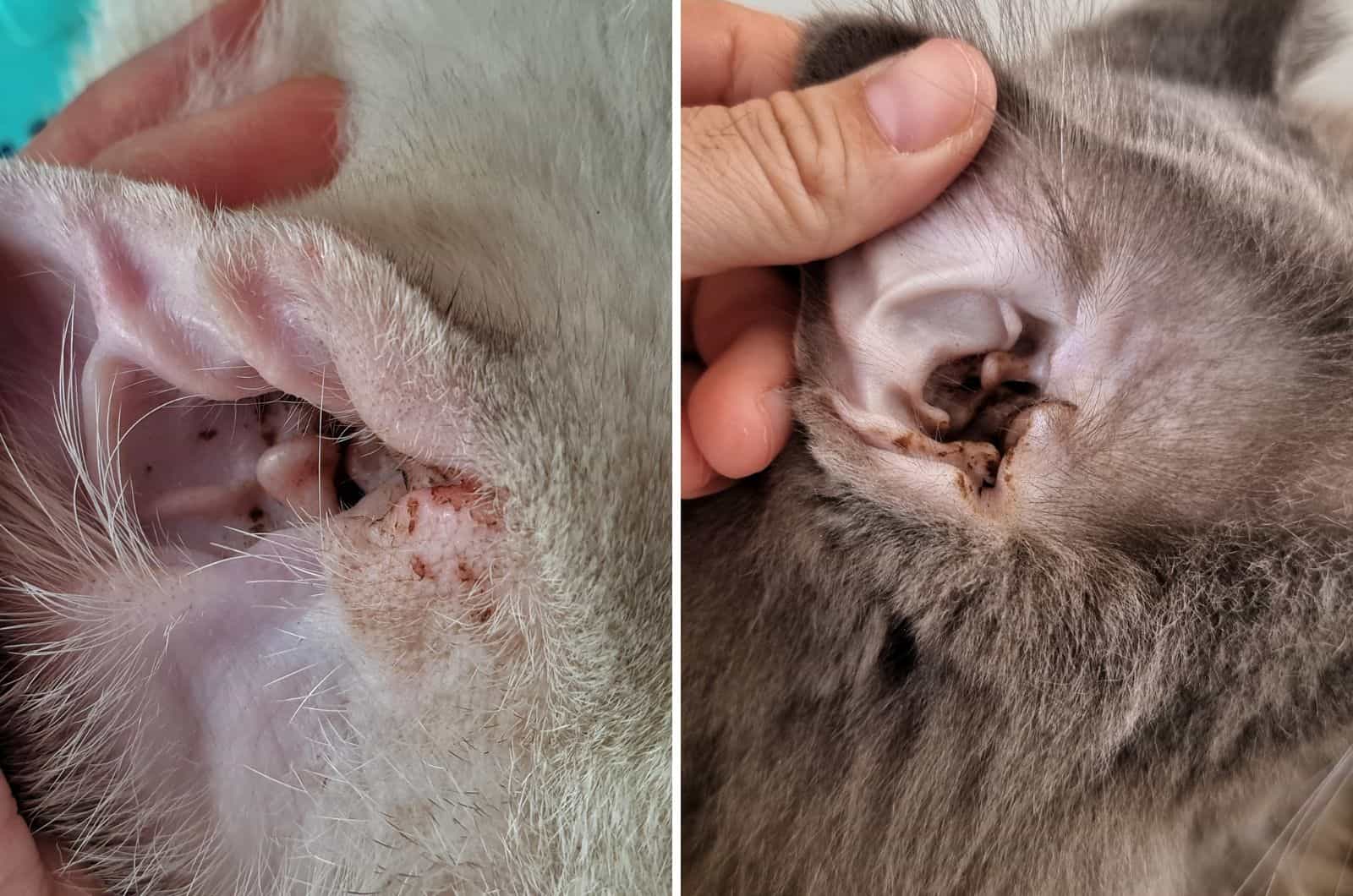
As I already said, ear wax is quite common in cats, but excessive ear wax is not. A cat with healthy ears usually has brown wax and pinkish ear skin, whereas dark discharge or any of the symptoms described above indicates a mite infestation.
Here’s a summary of some quick and simple methods to distinguish between the two:
Amount Of Earwax
The amount of wax varies if your cat has mites. As previously stated, mites actually feed on the wax, which causes your cat to produce more of it. Wax buildup also occurs if your cat has allergies, but with allergies come other allergy symptoms.
It is unlikely for you not to notice allergies since your cat will probably have watery eyes or sneeze. Fungal or bacterial infections can also occur.
Color Of Earwax
The most noticeable distinction between a healthy feline ear wax and ear mites is the wax color. Brown wax is healthy, whereas darker colors indicate ear mites.
Signs Of Inflammation
You should also look for typical signs of an ear infection. If there’s swelling, redness, or inflammation, then ear mites are likely to be present. However, if there are no signs of a problem like this, then there’s probably nothing to worry about.
Odor Of Ear Wax
The odor is another distinguishing feature between ear mites and ear wax. A healthy amount of ear wax will typically be almost odorless. Whereas the ear wax in the ear of an infected cat will have a foul odor.
How To Treat Ear Mites?
If you observe any symptoms that might indicate your cat has ear mites, you should consult a veterinarian. Your veterinarian can take a swab sample from your cat’s ears and examine it under a microscope to identify the underlying issue.
Antibiotics are frequently required for infections. This medication, however, is ineffective against ear mites or fungal infections. As a result, the vet must ascertain the exact cause. Otherwise, this type of therapy may be ineffective.
An anti-parasitic formula is most commonly used to treat ear mites. This formula is simple to use at the vet’s office and effectively eliminates these bugs.
A home remedy is sometimes used to relieve and cure infections. Cats may scratch their ears excessively, which can result in scabs that get infected. As a result, it is critical to keep their ears from becoming itchy while they heal.
How To Keep Your Cat’s Ears Healthy
The most important thing, as is key to any prevention method, is to inspect your cat’s ears on a regular basis. This is the best way to notice any symptoms or irregularities in general.
If you notice any of the signs of ear mites or are concerned about possibly abnormal wax, take your cat to your vet for diagnosis and therapy. After consulting with your vet, you can also give a few home remedies for dealing with cat ear mites a try.
Don’t put off seeking treatment; ear mites can cause permanent damage to your cat’s ear or eardrum, and even lead to deafness if left untreated.
What Other Causes Of Ear Discharge In Cats Are There?
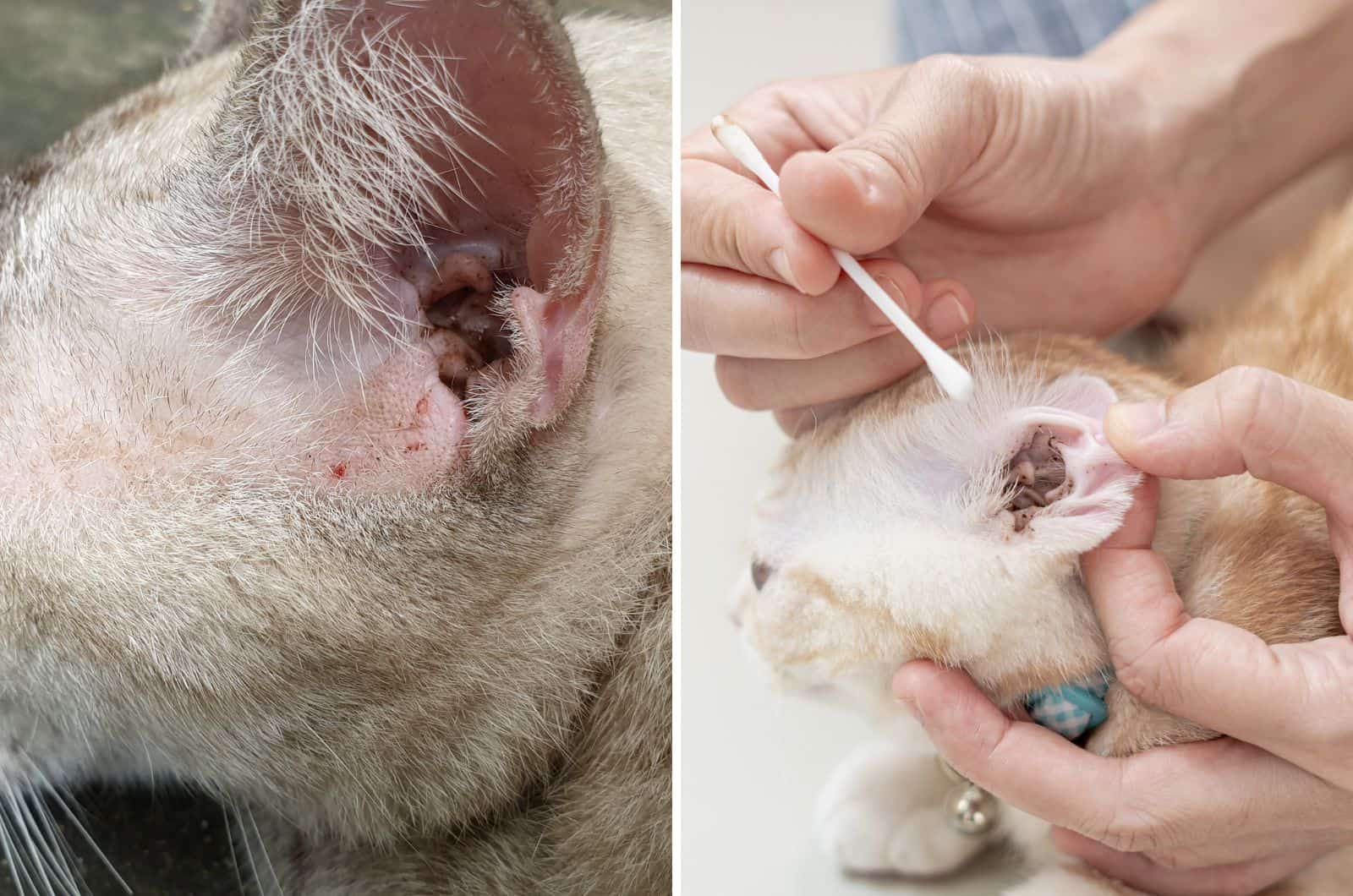
Ear mites are one of the most common ear problems in cats, next to trauma, injury, ear infections, allergies, or even a weakened immune system. Cats, like humans, can be allergic to a variety of things.
Your cat’s body produces too much ear wax while it attempts to fight off the allergy. Ear irritation is likely to follow as well, which is why cats scratch a lot.
You should also watch out for other symptoms of allergies, like coughing or sneezing, in the case of environmental allergies. Your cat might throw up hairballs in the case of a certain food allergy.
Yeast infections or bacterial infections of the cat’s ear are not that common. Healthy cats, overall, aren’t prone to ear infections. However, when they do occur, your vet will also check that there is no underlying medical condition.
Always consult your vet if you are not sure what is wrong with your pet. Your vet will always know and set the diagnosis for your cat. With the proper ear mite treatment, your cat’s hearing will be unaffected, and its ears will be healthy and clean.
FAQ
What should cat ear wax look like?
If your cat has healthy ears, they will be free of earwax and dirt, and they will be a healthy light pink color.
What kills ear mites in cats instantly?
The treatment usually starts with a thorough ear cleaning to remove any wax or dirt that may prevent topical treatments from reaching the mites.
There are numerous topical, oral, and systemic agents available. Pyrethrin-containing medications and products are the most effective at killing ear mites.
Can an indoor cat get ear mites?
Even indoor-only cats can get them, and once one pet in the house has them, the others are almost certain to get infected as well.
Otodectes cynotis is the name of the most common type of ear mite, which lives in the ear canal of pets and feeds off of their thin skin.
What can be used to clean cat ears?
Always consult your vet before you do something as sensitive as cleaning your cat’s ears. Generally, it is safe to use a cotton ball to clean the inside of your cat’s ears.
Your vet will advise you on the best type of cotton balls, or you can even use a tissue. Tissues can be better because, using cotton swabs, you risk damaging your cat’s eardrums.
Final Words
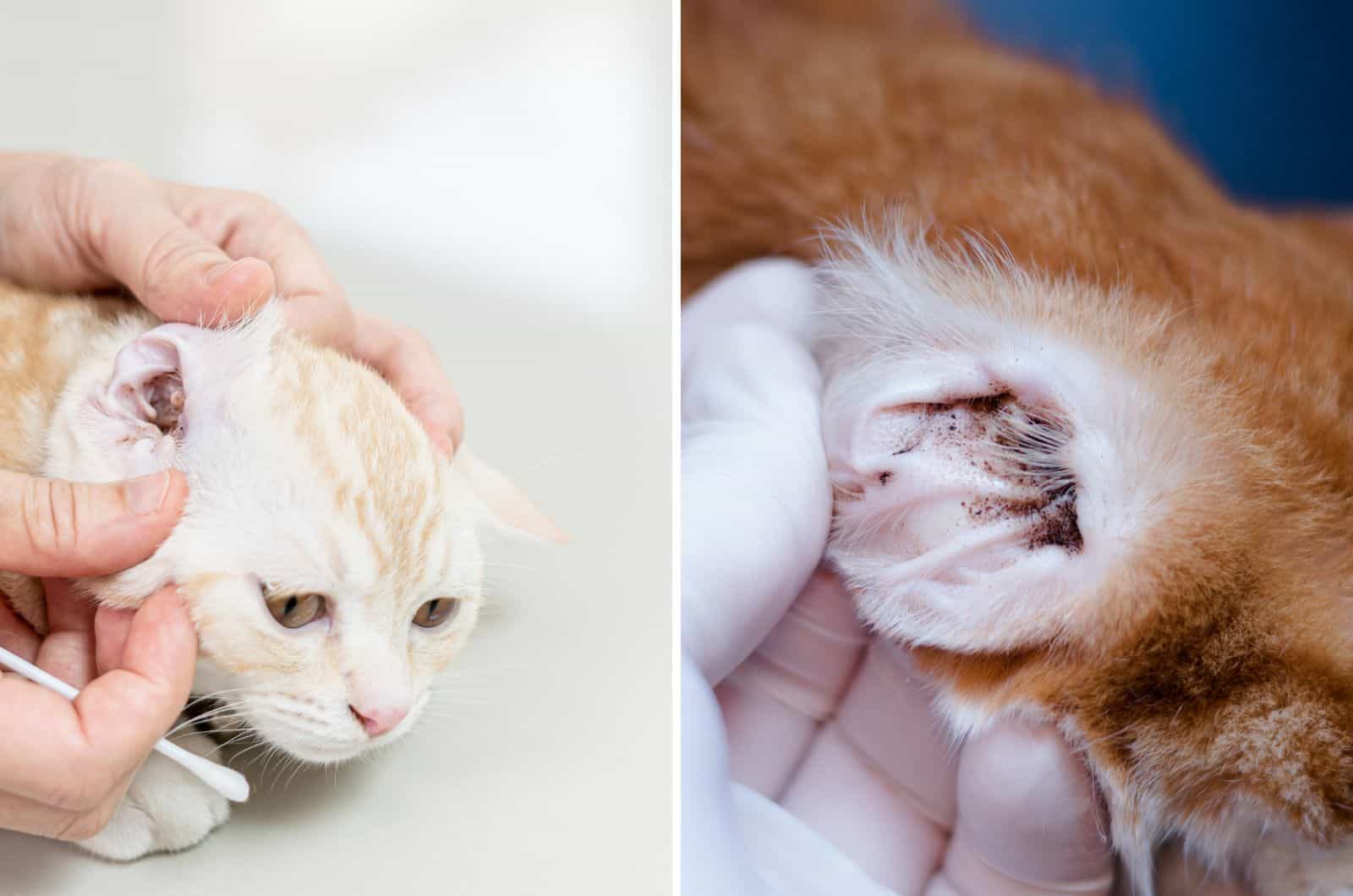
Ear mites and earwax are frequently found together. Due to the blood and skin problems created by ear mites, your cat’s ear wax will increase in amount and change color.
A cat with an ear infection or a cat infested with ear mites will most typically have darker earwax that smells.
A little ear wax, on the other hand, is nothing to be concerned about. This is good for keeping your cat’s ears healthy and helps to prevent ear infections.
Inspecting your cat’s ears on a regular basis can help you detect any changes, so you can act quickly if there’s a problem.
Related Articles:
• Cat Hair Loss On Ears – Should You Visit The Vet?
• Why Are Cats’ Noses Wet? Should You Worry, Or Is It Normal?
• All About Fever Coat Kittens And Their Magical Color-Changing Ability






